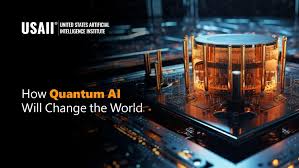Quantum AI & Neuromorphic Chips
In the scorching aspect of modern computing, there are two technologies that will transform our perception of what is possible by computing power, and artificial intelligence: Quantum AI and Neuromorphic Chips. All these are no longer a matter of wishful projection into the beyond; they are all now being subjected to serious study and demonstration in the laboratories of the world, and their future scope of influence is truly staggering, spanning a whole impressive array of fields including, of course, healthcare, but also including finance, defence, and even space-based exploration.
But the question that arises can be posed as follows: what is Quantum AI and Neuromorphic Chips, and why is it being touted as the future of smart computation? An organized investigation is called upon.
What is Quantum AI?
Quantum AI is at the nexus of the fields of quantum mechanics and computational cognition: the intentional combination of quantum computing with classical artificial intelligence. The classical hardware is based on binary logic gates, but quantum hardware takes advantage of quantum bits (qubits), which in the state of superposition and entanglement are able to be in a state simultaneously.
Computationally, the architecture physically translates to the reduction of the time necessary to train machine-learning models as well as to tackle complex optimization problems by a large margin. Training those models with high-dimensional data is often slow to converge; quantum AI, on the other hand, can explore a solution space exponentially higher in parallel, thus new possibilities of:
Auto-classification and entity recognition
• Natural-language processing
• Mutilmodal data scanning.
Iterative optimisation
Such merits are characterized by the nature of qubits as unique in quantum mechanics. To take an example, in iterative optimisation application, it may be possible to introduce a range of trial values into qubits all at once, and eliminate the values not converging whilst optimising the rest of the candidates- a task classic machines can never achieve.
-
Real-time language translation
-
Drug discovery and molecular modeling
-
Financial market predictions
-
Cybersecurity enhancements
What are Neuromorphic Chips?
We may start by creating a contextual framework. Modern microelectronics, particularly in the sphere of the CPUs and GPUs, has proceeded to the point where the processing limits have started to emerge prominently. Briefly, scaling limits of the classical transistor technology are near physical limits, and thus we are confronted with diminishing returns on continued geometric scaling.
In this background, outstanding alternative ROADMAP is the neuromorphic chips. These chips use a new paradigm inspired by the brain based on spiking neural networks (SNNs) rather than following the von Neumann architecture which is the basis of conventional processors. By doing that, they reproduce the same main communication topology that is evident on biological neurons.
The benefits are very pragmatic. The first reason is that SNNs allow the workloads to be processed with greater computational efficiency; the second reason is that the hardware footprint usually occupies less space hence reducing power consumption; and the third reason is the hardware itself is inherently asynchronous in nature, and hence you can achieve much lower latency (which has become one of the most important measures in edge-deployed systems).
When combined, these properties make neuromorphic chips especially effective in edge-computing situations, in which it cannot be expected that the intended dispatches of the computation to more distant clouds will occur. Localized intelligent processing run by such special devices can save the day in such contexts.
Key features of neuromorphic chips include:
-
Asynchronous signal processing
-
Event-driven computation
-
Adaptive learning mechanisms
-
Ultra-low latency and power
Major players like Intel (Loihi chip) and IBM (TrueNorth chip) are pioneering this space.
How Quantum AI and Neuromorphic Chips Complement Each Other
Each of the two paradigms that prevail in the modern research space, Quantum AI that essentially deals with the area of solving massively multidimensional problems and abstract-logic deductions, and neuromorphic computing, which concerns the scope of real-time perception, fast decision-making formation, and low-power learning. One of the most interesting architecture is obtained when the individual welds the two paradigms together. Picture a mixed-mode architecture where a neuromorphic edge has sensory streams collected, preprocessed and sent to a quantum computer to reason at a deep level, with theoretically no limits to reasoning–just like that in biological neural networks.
This synergy could lead to:
-
Fully autonomous AI systems that self-learn and adapt
-
Breakthroughs in natural language understanding
-
Advanced brain-computer interfaces
-
Quantum-enhanced robotic intelligence
Real-World Applications
1. Healthcare and Personalized Medicine
A current area of interest in quantum AI is the construction of protein structure and intra-molecular dynamics thereby speeding up the hunt to discover an intervention. Combining this type of computing power with neuromorphic hardware, exactly when such chips are installed in diagnostic devices, the constant monitoring of the patient and the development of a personalized treatment scheme becomes a possibility. In the short run, the combination of such technologies will help to improve precision medicine and bring more prompt, precise clinical care.
2. Financial Modeling and Fraud Detection
Fellow scientists, we should start with a remark of the ground: quantum AI is available to perform probabilistic calculations over large datasets with astounding accuracy. This level of computation makes quantum techniques essential in predictive analytics of modern finance. As an example, the scale-upable structure of quantum circuit allows very efficient and scalable inference that opens the window to the real-time high-fidelity forecasting.
What is complementing these trends is the advent of a class of neuromorphic hardware the neuromorphic chips, which are more capable in edge computing settings. This has led to the development of such devices which are modeled to simulate the biology of the neurons in the software to provide the promised latency sensitive use. In the retail sector, neuromorphic hardware may be used in the POS devices to identify abnormalities and counterfeit transactions in real-time.
To conclude, it can be pointed out that the synergistic synergy of quantum and neuro-inspired technologies is soon to transform the landscape of computability. The combination of them constitutes a strong versatile approach to solving the ever more complex and computationally demanding problems.
3. Smart Cities and IoT
In the field of modern sensory processing, a silicon circuit neurobiologically inspired to operate at low power is described as a neuromorphic chip. Using the architecture of smart city, such developments bring about distributed, always-on sensor networks, with the ability to analyze the traffic, track atmospheric pollutants, and even real-time firearm rounds fired. In a case in which a quantum-powered artificial intelligence is able to combine this citywide data, the resulting analytics can, in turn, be used to optimize the distribution grids of energy, optimize vehicular traffic routes, and inform the decision-making involved in city-planning processes.
4. Autonomous Vehicles
In the case of exploring recent edge computing networks, one will come across a type of device called neuromorphic chips. The devices allow processing of immense streams of sensory data: vision, radar, LiDAR, with a new degree of complexity in real time, all on-chip. They arecomparatively, quantum-assisted AI, which, emplaced in cloud platforms, are well-suited application of the simulation-driven inference to problems that involve chaos-like, non-linear dynamics of the underlying process. One example is especially useful, which is the forecasting of optimal driving performances under densely packed and unpredictable urban traffic. In this case, quantum simulation methods can predict traffic patterns at an unprecedented level of spatial and temporal detail, thus making an educated decision a possibility even while emergent events of congestion play out.
5. Space Exploration
The neuromorphic chips are especially an appealing prospect in the space crafts due mainly to their power efficiencies and hardiness. Such devices used together with quantum-enhanced artificial intelligence agency make it possible to plan autonomous decisions on interplanetary missions.
Industry Leaders & Research Highlights
In academic circles, the Sycamore quantum computer recently intoxicatingly manifested quantum supremacy a statement of computational superiority over classical computers. Concurrently, the AI department of the company is moving AI quantum machine learning algorithms to natural language processing and image recognition.
Intel
Intel’s Loihi 2 neuromorphic chip can run 1 million neurons and do real time learning & inference. It is being spread in robotics and smart sensors.
IBM
As every person, who has even the slightest knowledge of the current trends in quantum sciences, will understand, IBM takes the leading role in the field between the quantum computers and neuro-inspired research. One of its projects, Qiskit quantum software development framework in particular, has become absolutely essential in the creation of quantum-empowered AI algorithms.
DARPA & Military Interest
Fellow workers, the U.S. department of defense is putting a lot of resources into two promising technologies namely neuromorphic computing and quantum AI. The aim is to create robust autonomous defense systems and increase surveillance, and global communications security.
Neuromorphic computing computational replication of biological neural networks in silicon, provides fast processing and low-power computing. It has computational density unlike that of any other computer system, by imitating the structure of the human brain and the way it operates. Recent development has shown scales up to exascale performance.
Quantum AI, in its turn, relies on quantum mechanical features to obtain increased computational capabilities than classical computing can handle. Quantum circuit designs, quantum algorithms and error-correction schemes are also actively under research, with experimental proofs of concepts already up to thousands of qubits.
The combination of these technologies has potential to give defense planners an outstanding range of weapons in the battlespace of the future.
Challenges and Ethical Considerations
Quantum AI:
-
Hardware instability: Qubits are highly sensitive to environmental noise.
-
Algorithm development: Many quantum-AI algorithms are still theoretical.
-
Cost: Quantum computers remain extremely expensive and rare.
Neuromorphic Chips:
-
Limited software support: Few frameworks exist for SNNs compared to deep learning.
-
Scaling: While great for edge computing, integrating with large-scale cloud systems is complex.
-
Transparency: SNN behavior can be hard to interpret, posing explainability challenges.
Ethics:
-
Autonomy vs. Control: When intelligent systems can reason and learn independently, who’s accountable?
-
Surveillance: Edge devices with neuromorphic chips raise concerns about privacy.
-
Weaponization: Quantum and neuromorphic advances could lead to more autonomous weapons.
What the Future Holds
The combination of Quantum AI and Neuromorphic Chips promises a paradigm shift in AI’s capabilities, moving us closer to Artificial General Intelligence (AGI). Here’s what the near future could look like:
-
AI that can explain itself through better understanding of cause and effect
-
Emotionally intelligent robots capable of empathy and real-time interaction
-
Quantum-powered brain simulations to better understand consciousness
-
AI-powered scientific discovery at a scale never seen before
Governments and corporations alike must prepare for this shift by investing in quantum infrastructure, encouraging AI ethics education, and supporting open-source neuromorphic development.
FAQs
Q1: What makes neuromorphic chips better than traditional processors?
Neuromorphic chips are designed to mimic the brain’s efficiency, using less power and processing real-time data faster than traditional chips—making them ideal for edge AI.
Q2: Can quantum AI replace current AI models?
Not entirely. Quantum AI will complement, not replace, existing models. It’s best suited for solving optimization problems and simulating complex systems.
Q3: When will quantum AI be commercially available?
Quantum AI is in early development stages, but we may see commercial applications by 2030, especially in pharma, finance, and logistics.
Q4: Are neuromorphic chips secure?
Yes, and they may even enhance security, thanks to their ability to perform decentralized and contextual processing.
Q5: What are some examples of neuromorphic devices?
Examples include Intel’s Loihi, IBM’s TrueNorth, and BrainChip’s Akida—used in robotics, smart cameras, and hearing aids.
Conclusion
All I would like to emphasize is that quantum AI and neuromorphic chips are not the matter of fantasy stories anymore, as they have already managed to overcome the boundary between the fantastical and the real and continue to transform the artificial intelligence field.
With quantum problem solving at one end and biologically inspired processing at the other end we are dangerously approaching a paradigm shift which has the ability to revolutionize machine thinking and learning as well as machine evolution. This discussion has therefore gone past speed in computation systems but focuses on the systems that are not just faster but are smarter, more versatile, and actually intelligent.
Actually, this future is here.
Robotics in 2025: The Rise of Intelligent Machines Shaping Our Future






